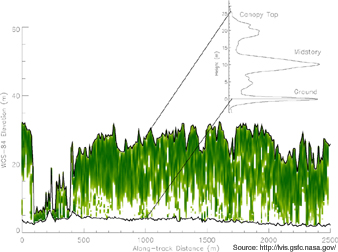
NASA's Laser Vegetation Imaging Sensor (LVIS) is an airborne laser altimeter system designed, developed and operated by the Laser Remote Sensing Branch, Goddard Space Flight Center. In 2003, LVIS obtained sub-canopy and canopy-top topography data as well as canopy vertical structure information for forested sites in New England to generate the most detailed forest structural data sets currently available for these regions. The LVIS consisted of a newly-enhanced laser altimeter instrument including digitally-recorded return waveforms, and integrated inertial navigation system (INS) and global position system (GPS) sensors that flew on the NOAA Cessna Citation aircraft during a one week mission in July 2003. The nominal footprint diameter during the mission was 20m (from ~10km altitude) to enable the imaging of entire tree crowns within each footprint.
 The sites overflown included Hubbard Brook Long Term Ecological Research (LTER) Site, Bartlett Experimental Forest, NH, Harvard Forest LTER, MA, Penobscot Experimental Forest, ME, and Howland Forest, ME. These sites were chosen because of the wealth of existing, complementary ground, air and space-borne data sets available to investigators. LVIS data available for these locations include the geolocated positions of both the ground and canopy top returns, as well as the relative heights of the 25%, 50%, 75%, and 100% (equivalent to the canopy top) return energy quantiles within each footprint. Geolocated waveform data within 2km of flux towers at the various sites are also available for download. Additional products derived from the waveforms are expected to be released within the coming months, including geotiff images of the products.
The sites overflown included Hubbard Brook Long Term Ecological Research (LTER) Site, Bartlett Experimental Forest, NH, Harvard Forest LTER, MA, Penobscot Experimental Forest, ME, and Howland Forest, ME. These sites were chosen because of the wealth of existing, complementary ground, air and space-borne data sets available to investigators. LVIS data available for these locations include the geolocated positions of both the ground and canopy top returns, as well as the relative heights of the 25%, 50%, 75%, and 100% (equivalent to the canopy top) return energy quantiles within each footprint. Geolocated waveform data within 2km of flux towers at the various sites are also available for download. Additional products derived from the waveforms are expected to be released within the coming months, including geotiff images of the products.
 Downstream uses of the data include estimating above-ground biomass and other forestry parameters such as stem diameter and basal area (Drake et al., 2002, 2003), distinguishing land use on the basis of canopy height (Peterson et al., 2004), habitat suitability (Hyde et al., 2004), aerodynamic roughness (Hurtt et al., 2004), and surface topographic change (Hofton et al., 2002).
Downstream uses of the data include estimating above-ground biomass and other forestry parameters such as stem diameter and basal area (Drake et al., 2002, 2003), distinguishing land use on the basis of canopy height (Peterson et al., 2004), habitat suitability (Hyde et al., 2004), aerodynamic roughness (Hurtt et al., 2004), and surface topographic change (Hofton et al., 2002).
The LVIS system and data production is a research project sponsored by NASA’s LBA-Airborne Program under grant number NAG512112. The New England data were collected in support of the NASA Terrestrial Ecology Program.

